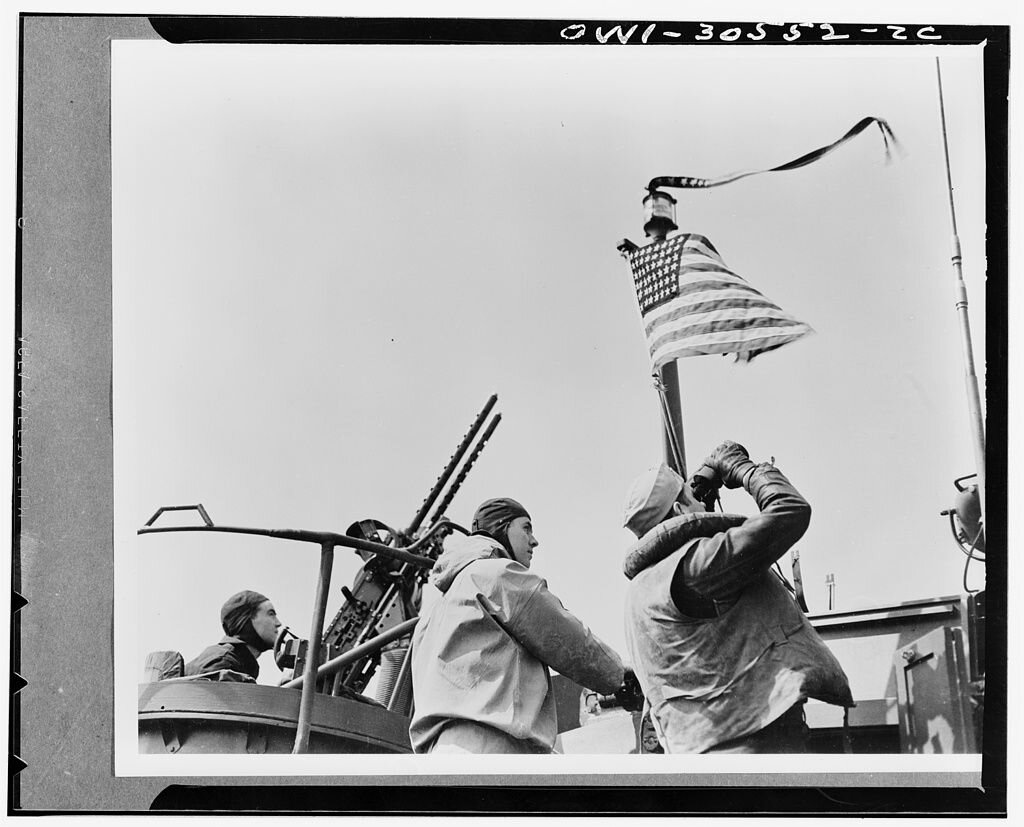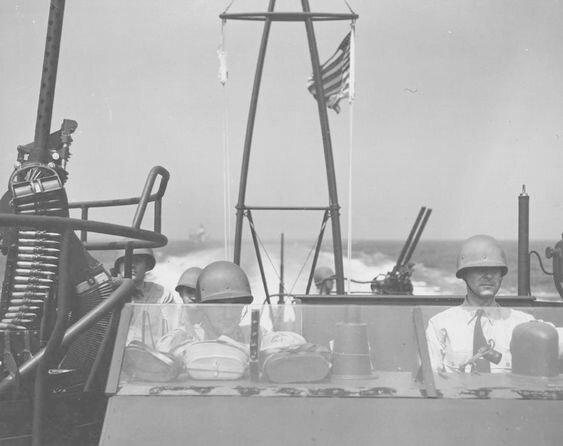Rare WWII 48 Star Naval Ensign PT (Patrol Torpedo) Boat Flag 'Salty Condition'*


























Rare WWII 48 Star Naval Ensign PT (Patrol Torpedo) Boat Flag 'Salty Condition'*
Comes with C.O.A.
Size: 57 in (4 feet 9 inches) x 33 in (2 feet 9 inches)
This extremely rare WWII 48 star U.S. Navy flag is marked ‘ALL WOOL NAVY 3 X 5’. This flag shows a ‘salty’ and worn condition with sailor and crew theater added ties around each of the two grommets. The stars as well as the white stripes show wear and stains expected from use from a salty ocean environment and sun exposure. Because of there small size PT boats are documented with being issued small MI ensign flags and ‘all wool navy’ flags of this size. Small ‘ALL WOOL NAVY 3 X 5’ flags were issued to PT boats (short for patrol torpedo boat) during WWII. PT boats were a motor torpedo boat used by the United States Navy in World War II. It was small, fast, and inexpensive to build, valued for its maneuverability and speed but hampered at the beginning of the war by ineffective torpedoes, limited armament, and comparatively fragile construction that limited some of the variants to coastal waters. In the USN they were organized in Motor Torpedo Boat Squadrons (MTBRONs). During World War II, PT boats engaged enemy warships, transports, tankers, barges, and sampans. Some were converted into gunboats, which could be effective against enemy small craft, especially armored barges used by the Japanese for inter-island transport. PT boats operated in the southern, western, and northern Pacific, as well as in the Mediterranean Sea, English Channel were they served during the Battle of Normandy. During the D-Day invasion, PTs patrolled the "Mason Line", forming a barrier against the German S-boats attacking the Allied landing forces. They also performed lifesaving and anti-shipping mine destruction missions during the invasion.
*Please note the BLACK and WHITE photograph is a digital photo found through historical research of this flag and similar flag types.
Below are historically documented accounts of PT boats and their use during WWII:
D-Day invasion
Some served during the Battle of Normandy. During the D-Day invasion, PTs patrolled the "Mason Line", forming a barrier against the German S-boats attacking the Allied landing forces. They also performed lifesaving and anti-shipping mine destruction missions during the invasion.
Solomon Islands campaign:
The effectiveness of PT boats in the Solomon Islands campaign, where there were numerous engagements between PTs and capital ships, as well as against Japanese shipborne resupply efforts dubbed "The Tokyo Express" operating in New Georgia Sound (called "the Slot" by the Americans), was substantially undermined by defective Mark 8 torpedoes. The Japanese were initially cautious when operating their capital ships in areas known to have PT boats, knowing how dangerous their own Type 93 torpedoes were, and assumed the Americans had equally lethal weapons. The PT boats at Guadalcanal were given credit for several sinkings and successes against the vaunted Tokyo Express. In several engagements, the mere presence of PTs was sufficient to disrupt heavily escorted Japanese resupply activities at Guadalcanal. Afterwards, the PT mission in the Solomon Islands was deemed a success.
Barge attacks:
Perhaps the most effective use of PTs was as "barge busters". Since both the Japanese in the New Guinea area and the Germans in the Mediterranean had lost numerous resupply vessels to Allied air power during daylight hours, each attempted to resupply their troop concentrations by using shallow draft barges at night in very shallow waters. The shallow depth meant Allied destroyers were unable to follow them due to the risk of running aground and the barges could be protected by an umbrella of shore batteries.
The efficiency of the PT boats at sinking the Japanese supply barges was considered a key reason that the Japanese had severe food, ammunition, and replacement problems during the New Guinea and Solomon Island campaigns, and made the PT boats prime targets for enemy aircraft. The use of PT boat torpedoes was ineffective against these sometimes heavily armed barges, since the minimum depth setting of the torpedo was about 10 feet (3 m) and the barges drew only 5 feet (1.5 m). To accomplish the task, PTs in the Mediterranean and the Pacific (and RN and RCN motor torpedo boats in the Mediterranean) installed more and heavier guns which were able to sink the barges. One captured Japanese soldier's diary described their fear of PT boats by describing them as "the monster that roars, flaps its wings, and shoots torpedoes in all directions."
Though their primary mission continued to be attack on surface ships and craft, PT boats were also used effectively to lay mines and smoke screens, coordinate in air-sea rescue operations, rescue shipwreck survivors, destroy Japanese suicide boats, destroy floating mines, and carry out intelligence or raider operations.
After the war, American military interviews with captured veterans of the Imperial Japanese Navy, supplemented by the available partial Japanese war records, were unable to verify that all the PT boat sinking claims were valid. Like many other victory claims by all parties involved (aircraft pilots, surface ships, submarines) this unclear verification was due in part to the Japanese military's policies of destroying military records.